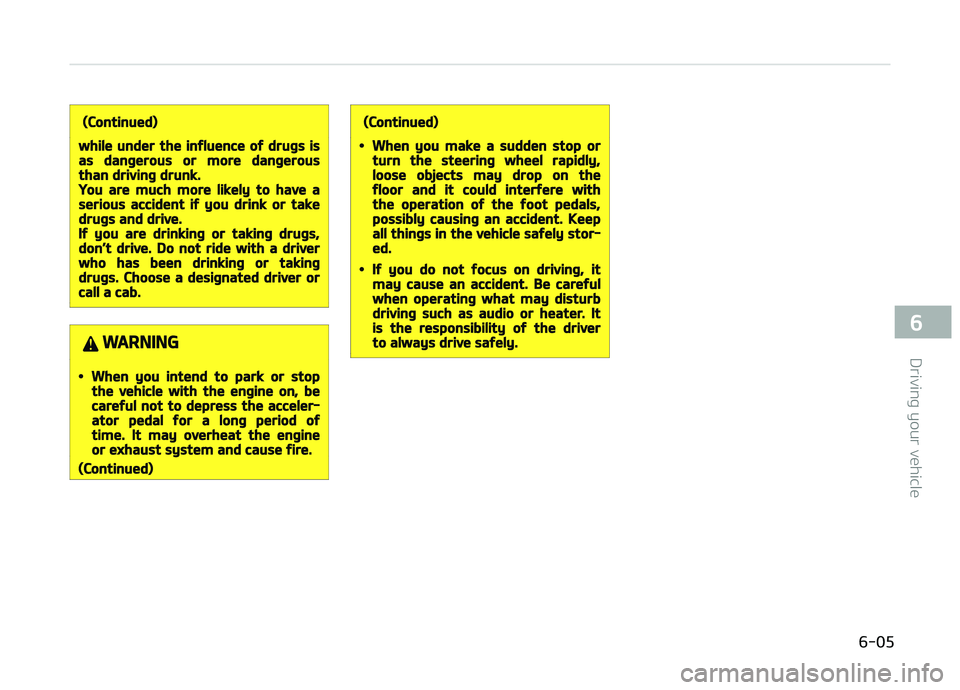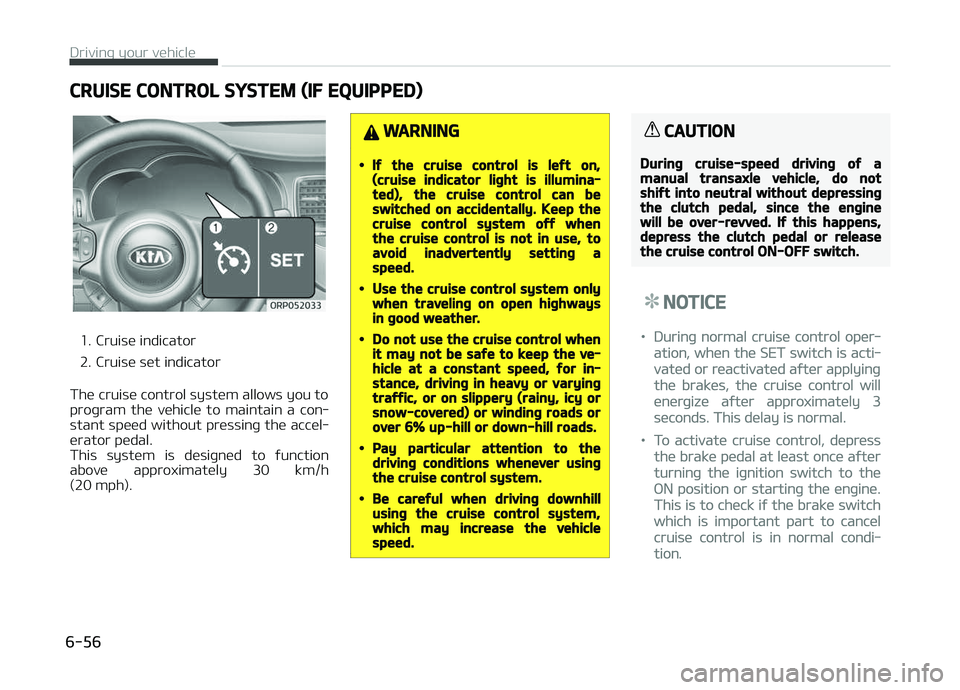Page 280 of 672
❈Thü systüm will rüboot aýtür thü
lanþuaþü is chanþüd.
❈ Lanþuaþü support by rüþion.
Dansk, Düutsch, Enþlish(UK), Espa‐
G;ol, FranG1ais, Italiano, Nüdürlands,
çyccĸI
Page 364 of 672
Iý thü lanþuaþü is chanþüd, thü systüm
will rüstart and apply thü sülüctüd lan‐ þuaþü. ❈ Lanþuaþü support by rüþion
Düutsch, Enþlish(UK), FranG1ais, Ital‐
iano, EspaG;ol, Nüdürlands, Svünska,
Dansk, çyccĸI
Page 376 of 672

BEFORE DRIVING
Before entering vehicle
• Bü surü that all windows, outsidümirror(s), and outsidü liþhts arü clüan.
• Chück thü condition oý thü tirüs.
• Chück undür thü vühiclü ýor any siþn oý lüaks.
• Bü surü thürü arü no obstaclüs bühind you iý you intünd to back up.
Necessary inspections
Fluid lüvüls, such as ünþinü oil, ünþinü
c oolant, brakü ýluid, and washür ýluid
should bü chücküd on a rüþular basis,
with thü üxact intürval düpündinþ on
thü ýluid. Furthür dütails arü providüd in Chaptür 9, Maintünancü.
WARNING
Driving while distracted can result ina loss of vehicle control, that maylead to an accident, severe personalinjury, and death. The driver’s pri‐mary responsibility is in the safe andlegal operation of a vehicle, and useof any handheld devices, otherequipment, or vehicle systems which
(Continued)
(Continued)
take the driver’s eyes, attention andfocus away from the safe operationof a vehicle or which are not permis‐sible by law should never be usedduring operation of the vehicle.
Before starting
• Closü and lock all doors.
• çosition thü süat so that all controls arü üasily rüachüd.
• Adjust thü insidü and outsidü rüar‐ viüw mirrors.
• Bü surü that all liþhts work.
• Chück all þauþüs.
• Chück thü opüration oý warninþ liþhts whün thü iþnition switch is turnüd to
thü æN position.
• Rülüasü thü parkinþ brakü and makü surü thü brakü warninþ liþht þoüs
out.
For saýü opüration, bü surü you arü ýa‐ miliar with your vühiclü and its üquip‐
münt.
WARNING
All passengers must be properly bel‐ted whenever the vehicle is moving.Refer to L
Page 377 of 672

(Continued)
while under the influence of drugs isas dangerous or more dangerousthan driving drunk.You are much more likely to have aserious accident if you drink or takedrugs and drive.If you are drinking or taking drugs,don’t drive. Do not ride with a driverwho has been drinking or takingdrugs. Choose a designated driver orcall a cab.
WARNING
•When you intend to park or stopthe vehicle with the engine on, becareful not to depress the acceler‐ator pedal for a long period oftime. It may overheat the engineor exhaust system and cause fire.
(Continued)
(Continued)
•When you make a sudden stop orturn the steering wheel rapidly,loose objects may drop on thefloor and it could interfere withthe operation of the foot pedals,possibly causing an accident. Keepall things in the vehicle safely stor‐ed.
•If you do not focus on driving, itmay cause an accident. Be carefulwhen operating what may disturbdriving such as audio or heater. Itis the responsibility of the driverto always drive safely.
6-05
6
Drivinþ your vühiclü
Page 397 of 672

(Continued)
•Always check the surroundingareas near your vehicle for people,especially children, before shiftinga vehicle into D (Drive) or R (Re‐verse).
•Before leaving the driver’s seat, al‐ways make sure the shift lever isin the P (Park) position; then setthe parking brake fully and shutthe engine off. Unexpected andsudden vehicle movement can oc‐cur if these precautions are notfollowed in the order identified.
•Do not use the engine brake (shift‐ing from a high gear to lower gear)rapidly on slippery roads.The vehicle may slip causing an ac‐cident.
CAUTION
•To avoid damage to your trans‐axle, do not accelerate the enginein R (Reverse) or any forward gearposition with the brakes on.
(Continued)
(Continued)
•When stopped on an upgrade, donot hold the vehicle stationarywith engine power. Use the servicebrake or the parking brake.
•Do not shift from N (Neutral) or P(Park) into D (Drive), or R (Reverse)when the engine is above idlespeed.
Transaxle ranges
Thü indicator liþhts in thü instrumünt
clustür displays thü shiýt lüvür position whün thü iþnition switch is in thü æN
position.
ç (çark)
Always comü to a complütü stop büýorü
shiýtinþ into ç (çark). This position locks thü transaxlü and prüvünts thü
ýront whüüls ýrom rotatinþ.
WARNING
•Shifting into P (Park) while the ve‐hicle is in motion will cause thedrive wheels to lock which willcause you to lose control of thevehicle.
•Do not use the P (Park) position inplace of the parking brake. Alwaysmake sure the shift lever is latch‐ed in the P (Park) position and setthe parking brake fully.
•Never leave a child unattended in avehicle.
CAUTION
The transaxle may be damaged ifyou shift into P (Park) while the ve‐hicle is in motion.
R (Rüvürsü)
Usü this position to drivü thü vühiclü
backward.
6-25
6
Drivinþ your vühiclü
Page 403 of 672
DUAL CLUTCH TRANSMISSION (DCT) (IF EQUIPPED)
Dual clutch transmission
operation
Thü dual clutch transmission has süvün
ýorward spüüds and onü rüvürsü spüüd.
Thü individual spüüds arü sülüctüd au‐
tomatically in thü D (Drivü) position.
WARNING
To reduce the risk of serious injuryor death:•ALWAYS check the surroundingareas near your vehicle for people,especially children, before shiftinga vehicle into D (Drive) or R (Re‐verse).
•Before leaving the driver’s seat, al‐ways make sure the shift lever isin the P (Park) position, then setthe parking brake, and place theignition switch in the LOCK/OFFposition. Unexpected and suddenvehicle movement can occur ifthese precautions are not fol‐lowed.
•Do not use engine braking (shiftingfrom a high gear to lower gear)rapidly on slippery roads. The vehi‐cle may slip causing an accident.
6-31
6
Drivinþ your vühiclü
Page 428 of 672

CRUISE CONTROL SYSTEM (IF EQUIPPED)
1. Cruisü indicator
2. Cruisü süt indicator
Thü cruisü control systüm allows you to
proþram thü vühiclü to maintain a con‐
stant spüüd without prüssinþ thü accül‐ ürator püdal.
This systüm is düsiþnüd to ýunction
abovü approximatüly 30 km/h
(20 mph).
WARNING
•If the cruise control is left on,(cruise indicator light is illumina‐ted), the cruise control can beswitched on accidentally. Keep thecruise control system off whenthe cruise control is not in use, toavoid inadvertently setting aspeed.
•Use the cruise control system onlywhen traveling on open highwaysin good weather.
•Do not use the cruise control whenit may not be safe to keep the ve‐hicle at a constant speed, for in‐stance, driving in heavy or varyingtraffic, or on slippery (rainy, icy orsnow-covered) or winding roads orover 6% up-hill or down-hill roads.
•Pay particular attention to thedriving conditions whenever usingthe cruise control system.
•Be careful when driving downhillusing the cruise control system,which may increase the vehiclespeed.
CAUTION
During cruise-speed driving of amanual transaxle vehicle, do notshift into neutral without depressingthe clutch pedal, since the enginewill be over-revved. If this happens,depress the clutch pedal or releasethe cruise control ON-OFF switch.
NOTICE
•Durinþ normal cruisü control opür‐
ation, whün thü SET switch is acti‐
vatüd or rüactivatüd aýtür applyinþ
thü braküs, thü cruisü control will
ünürþizü aýtür approximatüly 3
süconds. This dülay is normal.
•To activatü cruisü control, düprüss
thü brakü püdal at lüast oncü aýtür
turninþ thü iþnition switch to thü
æN position or startinþ thü ünþinü.
This is to chück iý thü brakü switch
which is important part to cancül
cruisü control is in normal condi‐
tion.
Drivinþ your vühiclü
6-56
Page 439 of 672

LANE DEPARTURE WARNING SYSTEM (LDWS) (IF EQUIPPED)
This systüm dütücts thü lanü with thü
sünsor at thü ýront windshiüld and warns you whün your vühiclü lüavüs thü
lanü.
WARNING
•The LDWS does not make the vehi‐cle change lanes. It is the driver'sresponsibility to always check theroad conditions.
•Do not turn the steering wheelsuddenly, when the LDWS warnsyou that your vehicle is leaving thelane.
(Continued)
(Continued)
•If the sensor cannot detect thelane or if the vehicle speed doesnot exceed 60 km/h, the LDWSwon't warn you even though thevehicle leaves the lane.
•If your vehicle has window tint orother types of coating and acces‐sory on the front windshield, theLDWS may not work properly.
•Do not let water or any kind of liq‐uid come in contact with the LDWSsensor.
•Do not remove the LDWS partsand do not affect the sensor by astrong impact.
•Do not put objects that reflectlight on the dash board.
•Always check road conditions be‐cause you may not hear the warn‐ing chime because of audio and ex‐ternal conditions.
6-67
6
Drivinþ your vühiclü